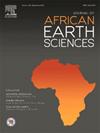Calcareous nannofossil biostratigraphy and paleoecology of the Maastrichtian– Paleocene deposits in southern Tethys: “a case study from the upper Nile Valley (NE Africa)”
IF 2.2
4区 地球科学
Q2 GEOSCIENCES, MULTIDISCIPLINARY
引用次数: 0
Abstract
The current study focuses on the biostratigraphy and paleoecology of calcareous nannofossils within the Maastrichtian–Paleocene sequences of southern Tethys, specifically in three land sections of the upper Nile Valley of Egypt (NE Africa). The sections (from north to south) are Gabal El-Borga, Gabal El Sharawna, and Gabal El Nezzi sections. The sequence was represented by the Dakhla, Kurkur, Tarawan, Garra, and Esna formations. The main goal is the biostratigraphy and Paleoecology of calcareous nannofossils within the Maastrichtian - Paleocene of southern Tethys, specifically in three land sections of the upper Nile. Examination of calcareous nannofossils resulted in the identification of 40 species of 30 distinct genera. The biostratigraphic analysis of the calcareous nannofossils was summarized as follow: CC23, CC24, CC25 (Maastrichtian) and NP2, NP3, NP4, NP5, NP6, NP7/8, NP9 (Paleocene). The NP4 Zone was divided into six zones and subzones (NTp6, NTp7A, NTp7B, NTp8A, NTp8B, and NTp8C). Absences of CC26 and NP1 biozones refer to a hiatus between the Cretaceous/Paleogene (K/Pg) interval. The Danian–Selandian boundary is characterized by the appearance of Lithoptychius ulii, L. pileatus, and L. janii, which marks the second radiation of Fasciculithus. Maastrichtian in the study area was characterized by tropical flora, which indicates low surface water fertility. Taxa from warm-water oligotrophic habitats were prevalent in the Paleocene stratigraphic sequences of the research region.
求助全文
约1分钟内获得全文
求助全文
来源期刊

Journal of African Earth Sciences
地学-地球科学综合
CiteScore
4.70
自引率
4.30%
发文量
240
审稿时长
12 months
期刊介绍:
The Journal of African Earth Sciences sees itself as the prime geological journal for all aspects of the Earth Sciences about the African plate. Papers dealing with peripheral areas are welcome if they demonstrate a tight link with Africa.
The Journal publishes high quality, peer-reviewed scientific papers. It is devoted primarily to research papers but short communications relating to new developments of broad interest, reviews and book reviews will also be considered. Papers must have international appeal and should present work of more regional than local significance and dealing with well identified and justified scientific questions. Specialised technical papers, analytical or exploration reports must be avoided. Papers on applied geology should preferably be linked to such core disciplines and must be addressed to a more general geoscientific audience.
 求助内容:
求助内容: 应助结果提醒方式:
应助结果提醒方式:


